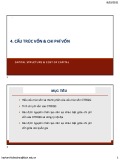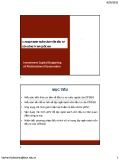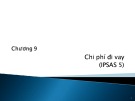International Financial Accounting
Chapter 5: Merchandise Inventory
Learning Objectives Define accounting principles related to inventory Define inventory costing methods Account for perpetual inventory using the three
most common costing methods
Compare the effects of the three most common
Chapter 5: Merchandise Inventory
inventory costing methods
Apply the lower-of-cost-or-market rule to
MA. Nguyen Quoc Nhat
inventory
Measure the effects of inventory errors Estimate ending inventory by the gross profit
method
Consistency Principle Disclosure Principle Materiality Concept Accounting Conservatism
5.1 Accounting Principles and Inventories 5.1 Accounting Principles and Inventories
Consistency Principle Businesses should use the same accounting methods from period to period. Consistency helps investors compare a company’s financial statements from one period to the next.
Materiality Concept A company must perform strictly proper accounting only for significant items. Information is significant—or, in accounting terms, material—when it would cause someone to change a decision.
5.1 Accounting Principles and Inventories 5.1 Accounting Principles and Inventories
Disclosure Principle Company should report enough information for outsiders to make wise decisions about the company. In short, the company should report relevant, reliable, and comparable information about itself. All major accounting decisions are described in the footnotes to the financial statements
MA. Nguyen Quoc Nhat- nhatnq.faa@gmail.com
1
International Financial Accounting
Chapter 5: Merchandise Inventory
Ending inventory = Number of units on
5.1 Accounting Principles and Inventories 5.2 Inventory Costing Methods
Accounting Conservatism means exercising caution in reporting items in the financial statements.
Cost of goods sold = Number of units
hand x Unit cost
Cost per unit = Purchase price –
sold x Unit cost
Purchase discounts – Purchase returns + Freight in
5.2 Inventory Costing Methods 5.2 Inventory Costing Methods
GAAP allows are as follows 1. Specific unit cost 2. First-in, first-out (FIFO) cost 3. Last-in, first-out (LIFO) cost 4. Average cost
1. Specific unit cost The company knows exactly which item was sold and exactly what the item cost. Suitable for businesses that sell unique, easily identified inventory items, such as automobiles (identified by the vehicle identification number [VIN]), jewels (a specific diamond ring), and real estate (identified by address)
5.2 Inventory Costing Methods
2. First-in, first-out (FIFO) cost The cost of goods sold is based on the
FIFO method assumes earliest goods purchased are the first to be sold
Often reflects the actual physical flow of
oldest purchases.
Under FIFO, companies sell their oldest
merchandise.
MA. Nguyen Quoc Nhat- nhatnq.faa@gmail.com
2
inventory first.
International Financial Accounting
Chapter 5: Merchandise Inventory
5.2 Inventory Costing Methods
LIFO method assumes latest goods purchased are the first to be sold
3. Last-in, first-out (LIFO) cost The cost of goods sold is based on the
Under the LIFO method, companies sell
most recent purchases (new costs)
their newest inventory first.
Allocation of the cost of goods available for sale in average cost method is made on the basis of the weighted average unit cost
MA. Nguyen Quoc Nhat
5.2 Inventory Costing Methods
4. Average cost The business computes a new average cost per unit after each purchase. Ending inventory and cost of goods sold are then based on the same average cost per unit. An average price is calculated and applied to all goods
5.2 Inventory Costing Methods
Average cost method assumes that goods available for sale are homogeneous
MA. Nguyen Quoc Nhat- nhatnq.faa@gmail.com
3
International Financial Accounting
Chapter 5: Merchandise Inventory
First-In, First-Out (FIFO) Method
5.3 Inventory Accounting in a Perpetual System 5.3 Inventory Accounting in a Perpetual System
Jul 15 Accounts receivable (4 $80) 320
Journal Entries Under FIFO Jul 5 Inventory (6 x$45) 270 Accounts payable 270 Purchased inventory on account
Jul 15 Cost of goods sold 170
Sales revenue 320 Sale on account
Inventory 170 Cost of goods sold.
5.3 Inventory Accounting in a Perpetual System
5.3 Inventory Accounting in a Perpetual System
Last-In, First-Out (LIFO) Method
Journal Entries Under FIFO July 26 Inventory (9 x$47) 423 Accounts payable 423
.
Purchased inventory on account. Jul 31 Accounts receivable 800 800
Sales revenue Sale on account. Jul 31 Cost of goods sold 462 Inventory 462 Cost of goods sold.
5.3 Inventory Accounting in a Perpetual System 5.3 Inventory Accounting in a Perpetual System
Jul 15 Accounts receivable (4 $80) 320
Jul 15 Cost of goods sold 180
MA. Nguyen Quoc Nhat- nhatnq.faa@gmail.com
4
Journal Entries Under LIFO Jul 5 Inventory (6 x$45) 270 Journal Entries Under LIFO July 26 Inventory (9 x$47) 423 Accounts payable 270 Accounts payable 423 Purchased inventory on account Purchased inventory on account. Jul 31 Accounts receivable 800 Sales revenue 320 800 Sale on account Sales revenue Sale on account. Jul 31 Cost of goods sold 468 Inventory 180 Inventory 468 Cost of goods sold. Cost of goods sold.
International Financial Accounting
Chapter 5: Merchandise Inventory
5.3 Inventory Accounting in a Perpetual System
5.3 Inventory Accounting in a Perpetual System Average-Cost Method
Jul 15 Accounts receivable (4 $80) 320
Journal Entries Under AVCO Jul 5 Inventory (6 x$45) 270 Accounts payable 270 Purchased inventory on account
Jul 15 Cost of goods sold 175
Sales revenue 320 Sale on account
Inventory 175 . Cost of goods sold.
5.3 Comparing FIFO, LIFO, and Average Cost
5.3 Inventory Accounting in a Perpetual System
.
Journal Entries Under AVCO July 26 Inventory (9 x$47) 423 Accounts payable 423
Purchased inventory on account. Jul 31 Accounts receivable 800 800
Sales revenue Sale on account. Jul 31 Cost of goods sold 460 Inventory 460 Cost of goods sold.
5.3 Comparing FIFO, LIFO, and Average Cost 5.3 Comparing FIFO, LIFO, and Average Cost
Fossil specializes in designer watches and leather goods. Assume Fossil began June holding 10 wristwatches that cost $50 each. During June, Fossil bought and sold inventory as follows: Jun 3 Sold 8 units for $100 each 16 Purchased 10 units @ $56 each 23 Sold 8 units for $100 each
MA. Nguyen Quoc Nhat- nhatnq.faa@gmail.com
5
Requirements 1. Prepare a perpetual inventory record for Fossil using FIFO, LIFO, and Average cost. 2. Journalize all of Fossil ’s inventory transactions for June under all three costing methods. 3. Show the computation of gross profit for each method. 4. Which method maximizes net income? Which method minimizes income taxes?
International Financial Accounting
Chapter 5: Merchandise Inventory
5.3 Comparing FIFO, LIFO, and Average Cost 5.3 Comparing FIFO, LIFO, and Average Cost
. .
5.3 Comparing FIFO, LIFO, and Average Cost
5.3 Comparing FIFO, LIFO, and Average Cost
.
.
5.3 Comparing - Example
5.3 Comparing FIFO, LIFO, and Average Cost
Date
Quantity Purchased
Cost of goods Sold
Quantity Unit cost
Quantity
Total cost
Unit cost
Total cost
Jul -1
4
48
5
6
50
8
5
?
15
7
48
26
6
?
31
9
52
1) Prepare a perpetual inventory record for Fossil using FIFO, LIFO, and
Average cost.
2) Journalize all of Fossil’s inventory transactions for June under all three costing
methods.
3) Show the computation of gross profit for each method. 4) 4. Which method maximizes net income? Which method minimizes income
taxes? www.themegallery.com
Company Logo
MA. Nguyen Quoc Nhat- nhatnq.faa@gmail.com
6
.
International Financial Accounting
Chapter 5: Merchandise Inventory
5.4 Lower-of cost-or-market rule
Lower of cost or market rule (LCM). LCM shows accounting conservatism in action and requires that inventory be reported in the financial statements at whichever is lower: ● the historical cost of the inventory, or ● the market value of the inventory.
5.4 Lower-of cost-or-market rule
5.4 Lower-of cost-or-market rule
Suppose Smart Touch paid $3,000 for its CD01 inventory. By July 31, the inventory can now be replaced for $2,200, and the decline in value appears permanent.
Market is defined as replacement cost or net realizable value. + If the replacement cost of inventory is less than its historical cost, the business must adjust the inventory value. + If the inventory market is greater than cost, then we don’t adjust the inventory account because of the conservatism principle.
5.3 Estimating Ending Inventory 5.3 Estimating Ending Inventory
MA. Nguyen Quoc Nhat- nhatnq.faa@gmail.com
7
. .
International Financial Accounting
Chapter 5: Merchandise Inventory
5.3 Estimating Ending Inventory
Suppose Smart Touch suffers a natural catastrophe and all its inventory is destroyed. Gross Profit Method of Estimating Inventory (amounts assumed)
Thank you!
MA. Nguyen Quoc Nhat
MA. Nguyen Quoc Nhat- nhatnq.faa@gmail.com
8


























